The Mountain Authority Unione Montana Spettabile Reggenza dei Sette Comuni, as the local authority established for the purpose of promoting the protection and the advancement of the territorial, economic, social, cultural, and environmental areas of the mountain, has supported and created the tourism promotion project “The Malga Trail”: this has been created to highlight the malgas of the Plateau of the Seven Municipalities (Altopiano dei Sette Comuni) through walking and biking trails, with the goal of raising awareness of the full potential of these territories at a local, national and international level.
The initiative, supported by the PSR 2014-2020 of the Veneto Region through a tender by GAL Montagna Vicentina, includes a series of information, promotion, and animation activities intended to provide incentive to visit the malgas and consequently generate positive economic effects for the entire project area. That is not the only aim of the project as agriculture on the mountain is an extraordinary instrument of preservation and protection of the Territory, as well as a means of creating employment opportunities.


The Mountain Authority Unione Montana Spettabile Reggenza dei Sette Comuni, as the local authority established for the purpose of promoting the protection and the advancement of the territorial, economic, social, cultural, and environmental areas of the mountain, has supported and created the tourism promotion project “The Malga Trail”:this has been created to highlight the malgas of the Plateau of the Seven Municipalities (Altopiano dei Sette Comuni) through walking and biking trailswith the goal of raising awareness of the full potential of these territories at a local, national and international level.
The initiative, supported by the PSR 2014-2020 of the Veneto Region through a tender by GAL Montagna Vicentina, includes a series of information, promotion, and animation activities intended to provide incentive to visit the malgas and consequently generate positive economic effects for the entire project area. That is not the only aim of the project, as agriculture on the mountain is an extraordinary instrument of preservation and protection of the Territory, as well as a means of creating employment opportunities.
In addition to the rural, historical, and economic values represented by the malgas, the initiative is also characterized by the enhancement of the places, traditions, and services of special importance for tourism from the standpoint of nature, the landscape, and the cultural heritage of one of the largest plateau areas in all of Europe.
The “Malgas” section of this website presents the malgas, a characteristic and unifying element of this territory, composed of the Municipalities of Asiago, Enego, Foza, Gallio, Lusiana Conco, Roana and Rotzo.
The 78 malgas under the jurisdiction of Public Authorities (Municipalities or Consortiums) of the Plateau of the Seven Municipalities have been all surveyed, photographed, filmed, and connected to itineraries, thereby facilitating their access and highlighting their peculiar qualities. In order to complete the tourism offer, the 10 malgas under the supervision of the Mountain Authority Unione Montana Astico have also been included, which are all located in the south western part of the Plateau. The malgas have therefore become ideal stops along beautiful trails with numerous interesting sites and landscapes, as they give visitors the chance to enjoy unforgettable experiences in the mountains and often to taste delicious malga products as well.
















On the website www.laviadellemalghe.it you can find all kinds of information on the malgas and the itineraries that connect them, some of which are available also in pocket-sized versions at the area tourist offices:
- pocket guide “Malgas guide”
- paper map “The Malga Trail – Walking and biking trails”


Malgas guide
The Plateau of the Seven Municipalities is a vast plateau located in Veneto, in the Vicentine Pre-Alps, bordering with Trentino. With a surface of 467 square km, it is a unique entity among national and European mountains due to the vastness of its pastures and the number of malgas (over 100, including public and private ones). They are of fundamental importance, not only from an agricultural/rural point of view, but also from an economic, historical, environmental, architectural, and tourism point of view:
- the malga is more than just the building where milk, cheeses, and cold cuts are produced (and often sold); it also includes the building that houses the personnel involved in the various tasks, the pasture, and the structures and infrastructures required for alpine grazing activities. Therefore, the malga represents a source of work and income;
- alpine grazing has been practised for centuries and although now typical products are made with innovative techniques and equipment, still the tradition is continued of using milk fresh from the udder and processed according to ancient rules;
- the surrounding pastures and woods host a wide variety of animal and plant species which contribute to the preservation of biodiversity. Furthermore, alpine grazing allows the territory to be maintained and constitutes an important form of prevention against hydrogeological instability;
- despite the fact that many malgas were destroyed during the First World War, there are still examples in the territory of ancient structures built entirely of wood with the Blockbau system, consisting in the overlapped stacking of larch or fir logs that had been squared and slotted at the ends to create refined corner joints. The malgas that were reconstructed around the ’20s and ’30s changed the wood structures into stone structures, maintaining in many cases the same features in terms of distribution, type, and period technologies, recognizable even today.
- As time passed, the malga gradually integrated a tourism vision with the agroalimentary, historical, naturalistic, and architectural aspects mentioned above, offering the tourist the possibility of enjoying an experience in contact with nature, to discover local lore, immersed in a harmonious and visually satisfying landscape thanks to the alternation of pastures, woods, and clearings.
Alongside the great wealth of the malgas spread across the territory, the Plateau also offers the possibility of reaching them from the main inhabited areas through an extensive network of roads, walkways and paths which are also connected to one another, giving the tourist the possibility of following very interesting looping itineraries.
The development of such network is due mainly to the infrastructures of the Great War, but also to the subsequent completion of capillary forestry-pastoral viability (primarily for timber clearing), facilitated by the territory’s particularly mild orography, with slopes that are not too steep.
It is precisely the joint presence of these two elements, the malgas and the connecting infrastructures, that is at the basis of “The Malga Trail” project which, through a series of itineraries suitable for both expert users or families seeking a simple outdoor activity, allows the discovery of even more aspects of the Plateau territory such as landscapes, nature, and historical and cultural elements.
The initiative undertaken therefore aims to translate this uniqueness into a true brand, “The Malga Trail”, capable of representing and spreading all the aspects that contribute to making malgas so attractive and that is at the basis of the information and distribution instruments created:
- the pocket-size multilingual information booklet;
- the multilingual tourist map;
- the multilingual website;
- the dedicated social media pages.
The goal of these instruments is to help people discover the Plateau territory, from the most well known locations to those less frequented, but by no means no less interesting; they provide the user with suitable information on the characteristics and services available in each malga, as well as on the itineraries that can be followed on foot and/or by bicycle, differentiated by level of difficulty so that choices can be made according to individual needs.

